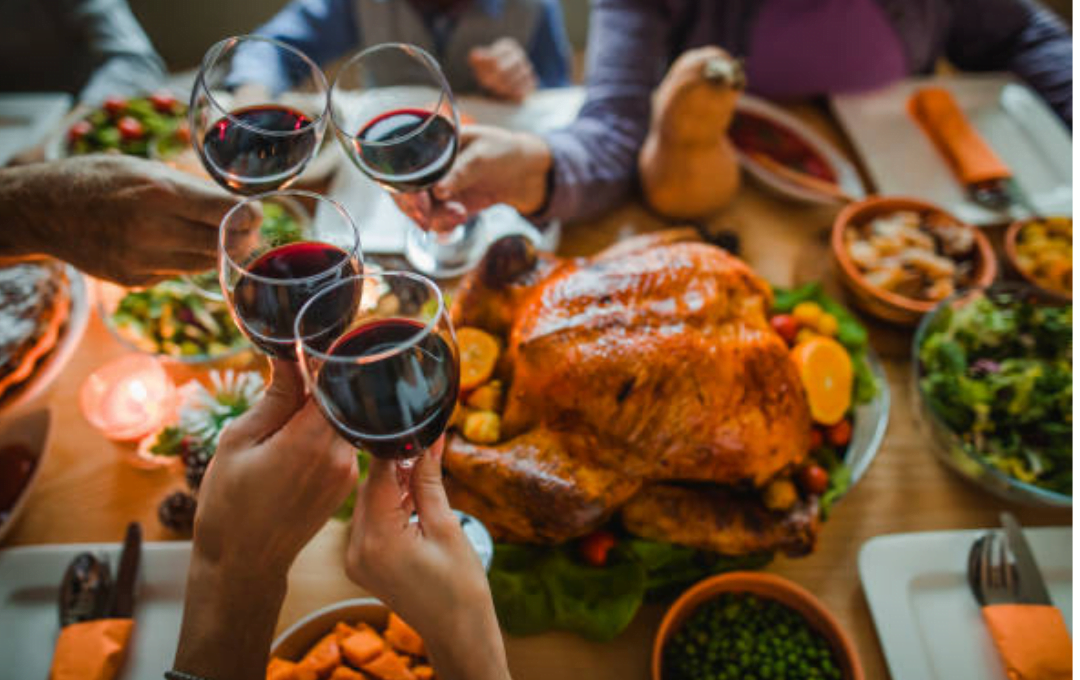Is the Thanksgiving Feast A Celebration Of Gratitude?

The Thanksgiving feast is a cherished tradition that holds a special place in the hearts of many. This annual celebration, rooted in the rich history of the United States, is a time to gather with loved ones, reflect on our blessings, and indulge in a bountiful spread of delectable dishes.
At the heart of the Thanksgiving feast lies the concept of gratitude. The origins of this holiday can be traced back to the early settlers of the New World, who, after enduring a harsh winter, came together with the Native Americans to celebrate a successful harvest. This act of giving thanks for the land’s bounty has since become a quintessential part of the Thanksgiving tradition.
Read: Quotes About Thanksgiving: Learn and Use Them Now
The Centerpiece: The Thanksgiving Turkey
The Thanksgiving feast is incomplete without the iconic roasted turkey. This majestic bird, often the centerpiece of the table, symbolizes the abundance and generosity that the holiday represents. The preparation of the Thanksgiving turkey is a time-honored ritual, with families passing down their cherished recipes and techniques from generation to generation.
Complementing the Thanksgiving turkey are a variety of delectable side dishes that have become integral to the feast. From the creamy mashed potatoes to the tangy cranberry sauce, each item on the table holds a special significance, adding depth and flavor to the overall dining experience.
The Thanksgiving Desserts
No Thanksgiving feast is complete without a selection of decadent desserts. Pumpkin pie, a staple of the holiday, is a beloved treat that evokes the warmth and comfort of the season. Other classic Thanksgiving desserts include pecan pie, apple pie, and the ever-popular sweet potato pie.
Giving Thanks and Sharing Blessings
The Thanksgiving feast is not just about the food; it is a time to reflect on the blessings in our lives and to share our gratitude with those around us. Many families have the tradition of going around the table and expressing what they are thankful for, a practice that reinforces the true spirit of the holiday.
The Thanksgiving Traditions
The Thanksgiving feast is steeped in a rich wealth of traditions, each one adding to the overall experience. From the breaking of the wishbone to the annual Macy’s Thanksgiving Day Parade, these customs have become an integral part of the Thanksgiving celebration.
The Thanksgiving feast is a unifying celebration that transcends cultural and religious boundaries. Across the United States, families and communities come together to share in the joy of the holiday, creating lasting memories and strengthening the bonds that tie us together.
A Reflection on the Past, a Celebration of the Present
As we gather around the Thanksgiving table, we are not only celebrating the present but also honoring the past. The Thanksgiving feast is a testament to the resilience and determination of those who came before us, and it serves as a reminder of the importance of gratitude, community, and the bountiful gifts that the land has to offer.
A Celebration of Gratitude and Community
At its core, the Thanksgiving feast is a celebration of gratitude and community. It is a time to come together, to share our blessings, and to strengthen the bonds that tie us to one another. As we gather around the table, let us remember the rich history that has brought us to this moment and the countless generations who have come before us, each one contributing to the tapestry of this beloved tradition.
How has the Meaning of Thanksgiving Evolved over time
The meaning of Thanksgiving has evolved significantly over time, from a religious observance to a national holiday celebrating gratitude and community:
- In the early days of the Plymouth Colony, Thanksgiving was a religious observance marked by days of prayer and fasting, rather than feasting. The mythologized 1621 harvest feast shared by the Pilgrims and Wampanoag was not considered the first Thanksgiving at the time.
- Over the 17th-19th centuries, Thanksgiving became an occasion for religious observance, with the presence of multiple meats emphasizing that it was a feast. The turkey took center stage during this period.
- In the mid-19th century, Sarah Josepha Hale advocated for Thanksgiving to become a national holiday, which led to Lincoln’s 1863 proclamation setting an annual fall Thanksgiving celebration. This cemented the tradition of Thanksgiving as a federal holiday.
- In the 20th century, Thanksgiving evolved into a holiday focused on gathering with family, eating good food, and expressing gratitude. However, for many Native Americans, it invokes a legacy of racism and mistreatment, leading to the tradition of Unthanksgiving Day.
- Today, Thanksgiving is a time for Americans to come together, reflect on their blessings, and strengthen the bonds of community. The holiday has transcended its religious origins to become a symbol of American culture and unity.
What role did the Pilgrims play in the development of Thanksgiving Traditions
The Pilgrims played a pivotal role in establishing the Thanksgiving traditions that we celebrate today:
The first Thanksgiving celebration in 1621 was held by the Pilgrims and the Wampanoag tribe after the Pilgrims’ first successful harvest in the New World. This gathering of the two groups to share a feast marked the origins of the Thanksgiving tradition.
The Pilgrims invited the Wampanoag to join them in this celebration, which included feasting on foods like venison, fowl, and crops like corn, beans, and squash that the Pilgrims had learned to cultivate with the help of the Native Americans.
While the menu was different from today’s Thanksgiving feast, this first celebration established the tradition of gathering together to give thanks for a bountiful harvest and to share a communal meal.
However, the idyllic image of harmonious relations between the Pilgrims and Native Americans is somewhat mythologized. The Pilgrims’ later interactions with other tribes were not always as peaceful, and their views on religious freedom and tolerance were quite narrow.
Nevertheless, the Pilgrims’ first Thanksgiving laid the groundwork for the national holiday we celebrate today, which has evolved to emphasize themes of gratitude, family, and community – values that resonate with the original spirit of that 1621 gathering.
What role did Sarah Josepha Hale play in establishing Thanksgiving as a National Holiday
Sarah Josepha Hale played a pivotal role in establishing Thanksgiving as a national holiday in the United States. Beginning in 1846, she used her position as the editor of the popular magazine Godey’s Lady’s Book to campaign for a national Thanksgiving celebration.
Hale wrote editorials twice a year in her magazine promoting the idea of a national Thanksgiving holiday on the last Thursday of November. She also wrote thousands of letters by hand to politicians, influential figures, and her wide network of friends and family, urging them to support her cause.
For nearly two decades, Hale persistently lobbied five U.S. presidents – Taylor, Fillmore, Pierce, Buchanan, and finally Lincoln – to officially establish Thanksgiving as a national holiday. In 1863, during the Civil War, President Lincoln finally agreed with Hale and issued a proclamation declaring the last Thursday of November as a national day of Thanksgiving.
However, Lincoln’s proclamation was only for 1863 and not an annual observance. Hale continued her campaign until her retirement in 1877, though she did not live to see Thanksgiving become a permanent national holiday. It was not until 1941 that Congress passed a law making Thanksgiving a national holiday on the fourth Thursday of November.
Through her tireless efforts over three decades, Sarah Josepha Hale is rightly considered the “Godmother of Thanksgiving” for her pivotal role in making the holiday a national tradition.
How did President Lincoln’s decision to make Thanksgiving a National Holiday affect the country
President Lincoln’s 1863 proclamation establishing Thanksgiving as a national holiday had a significant impact on the United States during the Civil War era:
Lincoln issued the proclamation in the midst of the devastating Civil War, calling on Americans to give thanks “in the midst of a civil war of unequaled magnitude.” Despite the immense suffering and division, Lincoln recognized the importance of cultivating national unity and gratitude.
Lincoln’s proclamation referenced the need to “heal the wounds of the nation” and “restore it as soon as may be consistent with the Divine purposes to the full enjoyment of peace, harmony, tranquillity and Union.” This reflected his desire for the holiday to help unify the country during the conflict.
Prior to Lincoln’s proclamation, Thanksgiving was celebrated sporadically by individual states, but he established it as a national holiday to be observed on the last Thursday of November. This helped standardize the celebration across the country.
Lincoln’s proclamation was influenced by the efforts of writer Sarah Josepha Hale, who had campaigned for decades to make Thanksgiving a national holiday. Hale believed a unified Thanksgiving could help ease tensions between the North and South.
Lincoln’s words in the proclamation, focusing on gratitude and hope despite the nation’s divisions, provided “inspiration” and a path forward during the tumultuous Civil War period. His proclamation helped shift the national mindset towards unity and resilience.
What are some modern ways people celebrate Thanksgiving differently
Some modern ways people celebrate Thanksgiving differently from the traditional feast include:
- Serving vegetarian or vegan dishes instead of turkey, such as vegetarian “turkey” made from tofu or other meat alternatives.
- Eating a variety of fruit and vegetable dishes rather than the classic turkey, stuffing, mashed potatoes, etc.
- Volunteering to serve food at homeless shelters or participating in canned food drives to help those in need.
- Participating in Thanksgiving Day races like the Detroit Turkey Trot to burn off calories before the big meal
- Focusing the holiday more on shopping, with extended mall hours and special deals for Black Friday, the day after Thanksgiving.
- Watching alternative parades like the Universal Orlando Resort Holiday Parade instead of the famous Macy’s Thanksgiving Day Parade in New York City.
- Celebrating the holiday’s origins by attending historical reenactments and visiting living history museums like Plimoth Plantation in Massachusetts.
What are some creative ways to use leftovers from a Thanksgiving feast
Here are some creative ways to use up your Thanksgiving leftovers:
Turkey Tetrazzini
This creamy casserole is made with leftover turkey, mushrooms, and a homemade sauce. It’s a classic way to reinvent dried-out turkey.
Thanksgiving Egg Rolls
These fun handheld egg rolls use up turkey, mashed potatoes, stuffing, and gravy all in one tasty package.
Thanksgiving Leftover Tacos
Shredded turkey is simmered in a mole-inspired sauce with gravy, chipotle chiles, and dark chocolate for a unique taco filling.
Cranberry-Glazed Turkey Meatballs
Turkey meatballs are glazed with sweet and tangy cranberry sauce for a fun appetizer or main dish.
Thanksgiving Potato Skins
Scoop leftover mashed potatoes into potato skins, top with turkey, stuffing, and cheese for a hearty appetizer.
Thanksgiving Leftover Casserole
Layer turkey, stuffing, mashed potatoes, and green beans in a casserole dish for a comforting one-dish meal.
Turkey Noodle Soup
Simmer the turkey carcass to make a rich broth, then add in leftover turkey meat and noodles for a classic soup.
Fried Mashed Potato Balls
Coat leftover mashed potatoes in breadcrumbs and fry for a crispy, delicious appetizer.






